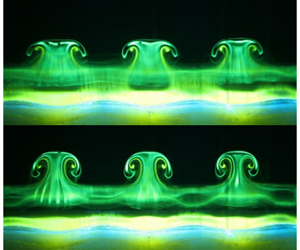Article contents
Impingement of a counter-rotating vortex pair on a wavy wall
Published online by Cambridge University Press: 21 May 2020
Abstract

In this paper, we investigate the impingement of a two-dimensional (2-D) vortex pair translating downwards onto a horizontal wall with a wavy surface. A principal purpose is to compare the vortex dynamics with the complementary case of a wavy vortex pair (deformed by the long-wavelength Crow instability) impinging onto a flat surface. The simpler case of a 2-D vortex pair descending onto a flat horizontal ground plane leads to the well known ‘rebound’ effect, wherein the primary vortex pair approaches the wall but subsequently advects vertically upwards, due to the induced velocity of secondary vorticity. In contrast, a wavy vortex pair descending onto a flat plane leads to ‘rebounding’ vorticity in the form of vortex rings. A descending 2-D vortex pair, impinging on a wavy wall, also generates ‘rebounding’ vortex rings. In this case, we observe that the vortex pair interacts first with the ‘hills’ of the wavy wall before the ‘valleys’. The resulting secondary vorticity rolls up into a concentrated vortex tube, ultimately forming a vortex loop along each valley. Each vortex loop pinches off to form a vortex ring, which advects upwards. Surprisingly, these rebounding vortex rings evolve without the strong axial flows fundamental to the wavy vortex case. The present research is relevant to wing tip trailing vortices interacting with a non-uniform ground plane. A non-flat wall is shown to accelerate the decay of the primary vortex pair. Such a passive, ground-based method to diminish the wake vortex hazard close to the ground is consistent with Stephan et al. (J. Aircraft, vol. 50 (4), 2013a, pp. 1250–1260; CEAS Aeronaut. J., vol. 5 (2), 2013b, pp. 109–125).
- Type
- JFM Papers
- Information
- Copyright
- © The Author(s), 2020. Published by Cambridge University Press
References
- 11
- Cited by




